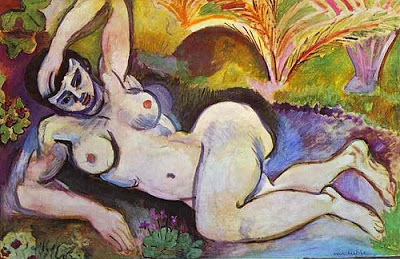
| Blue Nude: Memory of Biskra by Henri Matisse |
This post coincides with David Scott Allen’s current post (5/26/12) on Cocoa & Lavender. Entitled “When A Brownie Isn’t A Brownie,” David writes about two desserts that may well have been served on Saturday evenings at 27 rue de Fleurus in Paris in the early years of the last century.
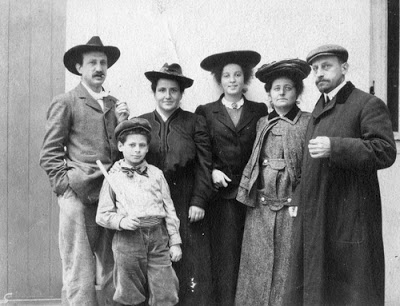 |
| From Left: Leo, Allan, Gertrude, Theresa Ehrman (nanny), Sarah, and Michael |
exhibition in New York, which is about a family of rather eccentric American intellectuals who collected the paintings of artists in Paris in the early 1900s, artists who, little did they know, would come to dominate modern art across the globe.
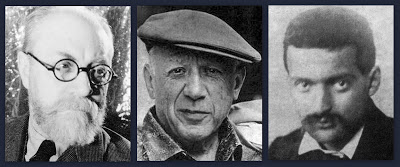 |
| Left to Right: Matisse, Picasso and Cézanne |
Provence was the subject of many of their paintings, especially Paul Cézanne who was born in Aix-en-Provence and single-handedly made famous Mont Sainte-Victoire, the mountain overlooking his native Aix.
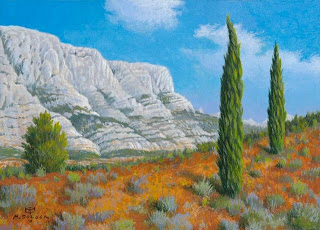 |
| Monte Dolack and his wife have followed the footsteps of these artists in Provence on several trips to France, staying in our apartments. To read more about their trips, see our Jan 2011 article here. |
Henri Matisse fell in love with the Cote d’Azur, where he captured many domestic and coastline scenes in and around Nice. The Rosaire Chapel in nearby Vence, where Matisse devoted four years to the architectural design of the building and every decorative detail, including the fabulous stained glass windows, was the “fruit of [his] whole working life.” He considered it his masterpiece.
Pablo Picasso was connected to several places in Provence and eventually bought a chateau in Vauvenargues, near the birthplace of Cézanne whom he felt was the father of his artwork. The artists’ hectic lives in Paris were punctuated by frequent vacations in Provence and all chose to live out their final years in Provence. All are buried in Provence.
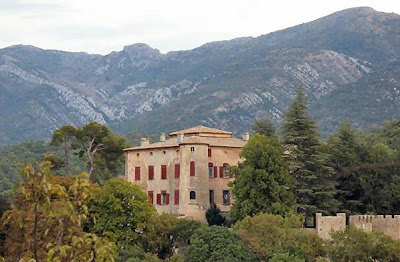 |
| Picasso’s Chateau de Vauvenargues where he is buried |
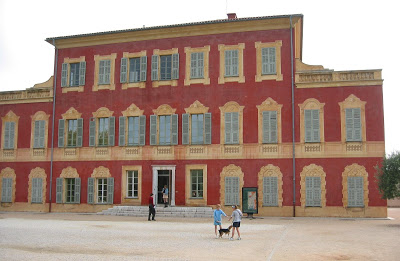 |
| The Matisse Museum in the 17th Century Villa des Arenes in Nice |
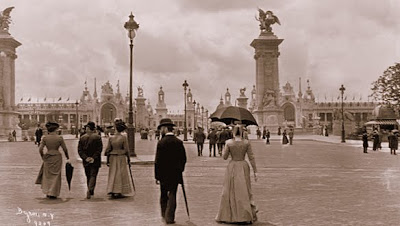 |
| Paris Exposition in 1900, the event that first drew Leo Stein to Paris |
Unlike other Americans who traveled to Gay Paris at the turn of the century, pockets lined with money and in search of art mainly as a source of investment that they quickly shipped home to their mansions, the Steins, although by no means impoverished, often had to pool their money to buy their art and it stayed with them in Paris. And with such limited funds, they were confined to artists who were just arriving on the Paris art scene.
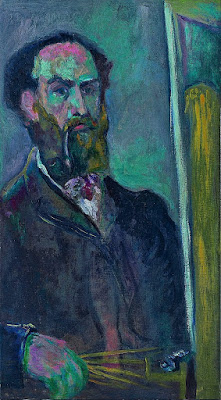 |
| Self-Portrait Leo Stein 1906-1908. Leo studied art at the Academie Julian and the Academie Matisse. |
The Saturday Salons lasted until about 1910 when, as Gertrude put it, the artists were known and even had their own agents. Leo had moved out, Alice Toklas who would become Gertrude’s life-long lover had moved in, and Gertrude was intent on pursuing other interests, like writing. Sibling rivalry had clearly surfaced and tensions were mounting among the Steins—Leo and Gertrude, whose bond had started the project, were growing apart and eventually would go their separate ways over the direction of Picasso’s artwork (toward Cubism), supported by Gertrude and disdained by her brother, and over Gertrude’s lesbianism, about which Leo objected. Leo moved to Italy. The War led to the dismantling of some of the art collection. Later, 27 rue de Fleurus would be the scene of other gatherings, but never with the same vibrancy that characterized the early years of the 20th century. Some would say that the center of attention at the gatherings had shifted to Gertrude and her literary career, not nearly as captivating a subject as the controversial art the family had amassed.
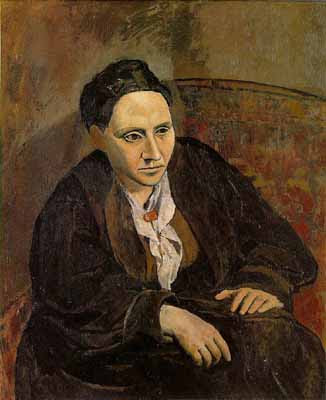 |
|
Gertrude Stein, Pablo Picasso 1905-1906. Gertrude wrote in
The Autobiography of Alice B. Toklas (1932) that she
posed upwards of 90 times for this portrait. |
The current exhibition consists of nine separate galleries—brimming with captivating paintings as well as postcards, letters, telegrams, personal photographs and furniture from #27—that tell the story of the Stein’s early years in Paris. Multimedia presentations supplement the exhibition making it one of the most educational shows I have ever had the pleasure of experiencing. There are some 60 paintings by Matisse, 40 paintings by Picasso, and at least a couple dozen by Cézanne among the paintings of many other now well–known artists. It may take you several hours to make your way through this vast collection.
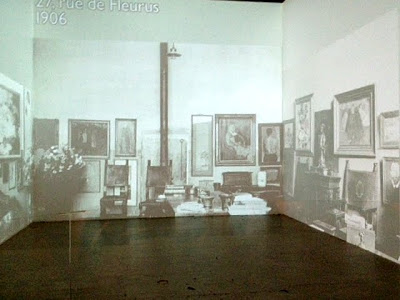 |
| Multimedia presentation in the exhibit showing 27, rue de Fleurus in 1906 |
Can you imagine that this wealth of modern art hung on the walls of two otherwise unremarkable apartments in Paris and that every Saturday for several years the avant-garde filled those apartments with conversation, debate, and intrigue? The mere thought is enough to take my breath away. No wonder Midnight in Paris is so captivating. No wonder Alice B. Toklas’s brownies are so mysterious.
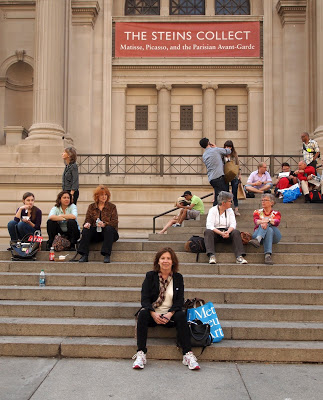 |
| After my Saturdays at theSteins’ |
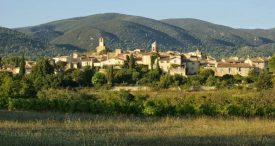
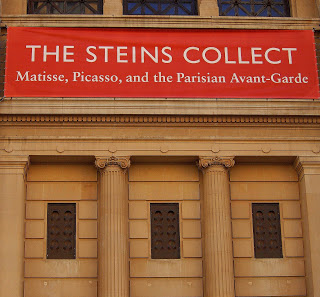
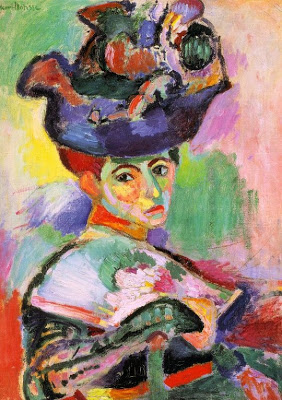





I am so glad that I can experience this exhibit through your eyes and words. I wonder if there are families these days who collect as such… Who will emerge as the Steins in 2112? I think I will go eat a spoonful of Alice B. Toklas' chocolate mousse and ponder that…
The Steins Collection, as you write, is a stellar exhibition. But, if one misses it, consider going to Philadelphia for a special show to feature Gaugin, cezanne and Matisse at the Museum of Art. Looks to be very interesting.
SUSAN,
Interesting as usual. I wish I could see it.
When I took art classes in college, the abstract form was just taking place. It was new and exciting and liberating. By liberating I mean, for artists, never having to paint realistic looking hands again!!
I have been to museums in Paris, Madrid, and New York. One thing I have always noticed is that artists have difficulty with painting hands that look realistic. Picassos version of fingers is like our comic strips, very primitive and simple.
I love Matisse's "Blue Nude". She would be in style today and labeled "obese", unless Michelle Obama put her on the carrot stick diet. Then she would be in fashion and labeled
"annorexic".
I like her the way she looks in the painting and I would label her"Happy and comfortable in her own Skin!!"
You have made me want to know more about Gertrude Stein, someone who has never been appealing to me! Very interesting post. I won't be anywhere near New York, but am inspired to see other similar exhibits and maybe even read more about Ms. Stein.
Dear ,
they are right looking for the historic truth about Gertrude Stein in this however wonderfull exhibition,"The Steins Collect;Matisse,Picasso,Cezanne and the Parisian Avant Garde" in NewYork at the Metropolitan Museum of Art .
Because what a pleasure to see the portrait of Gertrude Stein by Riba-Rovira .Who was as Picasso an antifascist and antinazi artist .Persecuted by Franco and the Nazis .
But who is in this exhibition ,thanks to Rebecca Rabinow and Edward Burns, perhaps
the only one artist would fought them weapons in his hands .
Whose father was in jail after the spanish civil war .So Riba-Rovira is beside Tchelitchew and Balthus and Francis Rose near Picabia and Picasso in the last room of this exhibition with Cézanne, Matisse .
And you have an interesting article in Appollo London Revew about him .And also in Artes Magazine from San Francisco where the exhibition was before .
But the main document as a revelation is with the mention beside the picture with the Preface Gertrude Stein wrote for first Riba-Rovira's exhibition in the Galerie Roquepine in Paris on 1945 .
Where we can read Gertrude Stein writing Riba-Rovira "will go farther than Cezanne…will succeed in where Picasso failed…I am fascinated " by Riba-Rovira Gertrude Stein tells us .
And you are you also fascinated indeed as Gertrude Stein by Riba-Rovira ?
Me I am when I see « L’Arlequin » on the free access website of « Galeria Muro ».
But Gertrude Stein spoke also in this same document about Matisse and Juan Gris .
Riba-Rovira went each week in Gertrude Stein's saloon rue Christine with Masson ,Hemingway and others. By Edward Burns and Carl Van Vechten we can know Riba-Rovira did others portraits of Gertrude Stein .
But we do not know where they are ;and you do you know perhaps ?
With this wonderful portrait we do not forget it is the last time Gertrude Stein sat for an artist who is Riba-Rovira .
This exhibition presents us a world success with this last painting portrait before she died .And her last Gertrude Stein's Art Retrospective before dead .
It illuminates the tone as an esthetic light over that exhibition now at the Metropolitan Museum of Art of New York thanks to Curator Rebecca Rabinow .
Coming from San Francisco "Seeing five stories" in the Jewish museum to Washington in National Portrait Gallery .And now in the Metropolitan Museum of Art of New York for our pleasure .
And the must is to see for the first time in the same place portraits by Picasso, Picabia, Riba-Rovira, Rose ,Tall-Coat, Valloton .Never before it was .
You have the translate of Gertrude Stein's Riba-Rovira Preface on english Gertrude Stein's page on Wikipedia and in the catalog of this Roquepine exhibition you can see in first place the mention of this portrait .And also other pictures Gertrude Stein bought to Riba-Rovira .
There is another place where you can see now Riba-Rovira's works in an exhibition in Valencia in Spain "Homenage a Gertrude Stein" by Riba-Rovira in Galleria Muro ,if you like art …
But we do not missed today that all over Europe a very bad wind is blowing again bringing the worth in front of us .And we must know that at least were two antinazis and antifascists in this exhibition but the only one fighting weapons in hands would be Riba-Rovira who did one of the first three « affiches » supporting Republicans in the beguining Spanish civil war .
Seeing Potrait of Gertrude Stein by Riba-Rovira in the Metropolitain Museum of New York with Picasso ,Cézanne ,Matisse we feel a recreation of spirit .
Hi David,
I wish I could join you and your mousse….but I know where to find the recipe!
One of my readers, a professor at Johns Hopkins, wrote to tell me that the Baltimore Museum of Art has a very nice collection of Matisse which, he said, is part of the larger collection of the Cone sisters (who were from Baltimore and were also collectors of art in Paris and friends of the Steins).
Sounds like a good tip!
Paintings do tell us so much about the period in which they were painted, don't they? So much history embedded in the work.
Not being an artist, I have to confess that I don't think I have ever tried to draw a hand, but I suspect I would not be successful. I will now take note of how others do it!
Thanks for your interesting and provocative observations!
Ah, great! You have a worthy and interesting goal! Keep us posted!
I am glad that you were so moved by the post. Thank you for your spirited note!